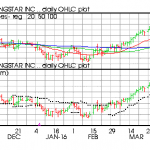Video length: 00:05:54
On the latest edition of Market Week in Review, Senior Investment Strategist Paul Eitelman and Rob Cittadini, director, Americas institutional, discussed the U.S. employment report for April, newly-released economic data from the Eurozone, and the status of trade talks between the U.S. and China.
Strong labor market sends U.S. jobless rate below 4%
New data from the U.S. Bureau of Labor Statistics showed that the country added 164,000 jobs in April—slightly below consensus expectations, but still a fairly healthy number overall, Eitelman said. More significantly, the nation’s unemployment rate dropped to 3.9%—an unexpected dip that amounts to the lowest jobless rate in 18 years. “This was a significant change,” he remarked—“ and it shows that the labor market is still very strong.” He added that wage growth during April was similar to March, coming in between 2.5 to 3.0% year-over-year, depending on the exact calculations or measures used.
So, how could this data play into future U.S. Federal Reserve (the Fed) decisions on interest rate increases? The central bank focuses on two factors overall in regard to this, Eitelman said: Full employment and price stability. “Given the latest unemployment numbers, they’ll probably say job done,” he said, adding that with core inflation moving very close to the Fed’s target goal of 2%, the central bank probably feels it’s nearing the point of mission accomplished on this front as well. Put together, both numbers will likely signal to the Fed that it can continue onward with roughly the same pace of interest rate increases as before—probably four a year or so, in Eitelman’s view.
European markets react to latest inflation report
Turning to Europe, Eitelman said that the latest economic data for the region came in a bit softer, with GDP growth slowing to 0.4% during the first quarter, according to Eurostat. In addition, the IHS Markit Eurozone Manufacturing Purchasing Managers’ Index™ (PMI) number for April dropped to 56—the lowest level in 13 months. Inflation also sank to 1.2%, year-over-year, per Eurostat, which Eitelman called a pretty significant downward surprise.











Leave A Comment